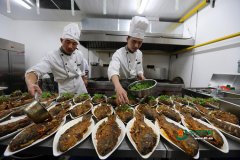中国远航舰队(Chinese Yuanhang Fleet)(2)
编辑:高中作文网 阅读 次这只锤头鲨是在也门荷台达附近的红海捕获,它身上的鳍可能会跑到中国人的餐桌上──鱼翅羹在中国被视为珍馐佳肴。在明代(公元14世纪至17世纪中期),也门与阿拉伯半岛上其它国家的航海商人确实在整个印度洋地区带动了蓬勃的商业。当郑和于1408年出航时,他的船队是当代最强大、最威震八方的。在欧洲人开始认真展开海洋探险之前将近一个世纪,郑和就已经率领着数以百计的船只与数以万计的船员航向大海。
At the bottom end of a soaring market, an ethnic Chinese worker squats in a sluice to gather tin ore at a mine on Bangka Island off the Sumatran coast. Zheng's crewmen found a Chinese community already settled on this Indonesian island when their ships called at Bangka to trade for tin and other goods. Prices for the metal rose substantially in 2004, and abandoned mines are being reworked as demand grows, particularly within China's vigorous economy.
在苏门答腊外海邦加岛的一处矿场,一名华裔工人蹲在一个洗矿槽内采集着锡矿砂。当郑和的船员来到邦加岛进行锡矿与其它商品的贸易时,已经有一个中国人社群定居在这个印尼的岛屿上。锡的价格在2004年上涨了不少,而随着需求增加──特别是在中国蓬勃的经济发展之下──废弃的矿场也重新启用。
On Pate Island along the Swahili coast of Kenya, the Mohame family pounds corn to make cornbread, a staple of their diet. The Mohameds are one of three families of the Famao clan who claim Chinese lineage. According to local legend, shipwrecked sailors from Zheng's fleet made it to shore and married local women, a belief that has become a central part of the Famao's personal mythology. Hints of past Chinese presence still exist on the island: Local tombs and lion statues have designs that some believe closely resemble those of the Ming era, and bits of Chinese ceramics that have washed ashore decorate the facades of some houses.
在肯尼亚斯瓦希里(Swahili)海岸上的培迪岛,默哈姆一家人打磨玉米制作他们的日常食物──玉米面包。默哈姆家族是宣称拥有中国血统的“法茂”氏族中的三个家族之一。根据当地传说,遇上船难的郑和船队水手游上了岸、跟当地妇女通婚,这样的想法已然成为法茂氏族个人神话中很重要的一部分。至今岛上依然可以瞥见中国人曾经到此一游的痕迹:有些人认为,当地坟墓与石狮子的样式跟明代中国的设计非常相似,而某些房屋的门面上则装饰着被海浪冲上岸的中国陶器碎片。
Dhows lie beached near Ra's al Hadd in Oman, their hulls sealed with a coating of cement and animal fat. For Arab countries the dhow has been the workhorse of the Indian Ocean, just as the junk has been for the Chinese in Southeast Asia. Zheng's fleet stopped here to trade porcelain for frankincense, myrrh, and aloe.
在阿曼的拉斯哈德附近,一艘艘三角帆船躺在沙滩上,船壳上涂着胶合剂与动物脂肪的混合物。三角帆船一直是阿拉伯人在印度洋的主力交通工具,一如中国人仰赖木帆船往返东南亚。郑和的船队曾经停靠在此,以瓷器交换乳香、没药与芦荟。
Incense perfumes the air at Tay Kak Sie, a Chinese Buddhist temple in Semarang, Indonesia—one of several in Southeast Asia where Zheng He's memory is revered. Its sister temple, Sampokong, was built to honor Zheng's reported appearance in Semarang to visit Wang Jinghong, his vice commander, who was laid up in a cave to recuperate from illness. A Central Asian Muslim by birth who was sympathetic to other religions, Zheng is thought to have been buried at sea after dying on the fleet's seventh and last voyage. A tomb—purportedly empty—stands outside Nanjing, China. It bears an Arabic inscription: "Allahu Akbar" ("God is Great").
在印尼三宝的一座中国佛寺,空气中弥漫着薰香的气味──这是东南亚几处敬拜郑和的地点之一。由于传说郑和曾到三宝来探视他氅下的副指挥官(当时正在此地的一座山洞里养病),人们还建了一座姊妹庙来纪念这个事件。血统上属于中亚回人的郑和能够宽容接纳其它信仰,据信他是死于最后一趟航程上,最后举行了海葬。中国南京城外有一座他的坟墓,据说是空坟。坟上刻着一句阿拉伯文:“Allahu Akbar”(伟哉神也)。




